Technology
PROPERTY| ROTATIONAL MOULDING
Rotational molding is an atmospheric pressure process that produces nearly stress-free parts. The fact that there are no stresses on the melt as it is shaped is a major advantage that rotational molding has over all other manufacturing methods for plastics parts. Also, as there are no forces on the plastic melt during forming, rotational molds can have thin walls and are relatively inexpensive to fabricate. For simple parts, mold delivery times can be a few days or weeks. Modern, multi-armed machines allow multiple molds of different sizes and shapes to be run at the same time. With proper mold design, complex parts, such as double-walled containers, that are difficult or impossible to mold by any other method, can be rotationally molded. With correct process control, the wall thickness of rotationally molded parts is quite uniform, unlike structural blow molding or twin-sheet thermoforming.
THIKCNESS
The internal angles tend to have less thickness as the time in contact with the material is less: it is for this reason that radius on internal corners have to be greater in relation to those of external corners. Large radiuses improve the flow of the material inside the mould and help to distribute the stress over a wider area, increasing the strength of the part. In the external corners there is a greater material thickness. This can be useful in zones where stress and wear are greater.
A recommended standard radius for polyethylene is:
• 5 mm for external angles (in any case always R>2 times the wall thickness)
• 10 mm for internal angles (R>4 times the wall thickness).
More rigid materials, like polyamide, require wider radiuses. They are recommended with values over:
• 10 mm for external angles
• 20 mm for internal angles
